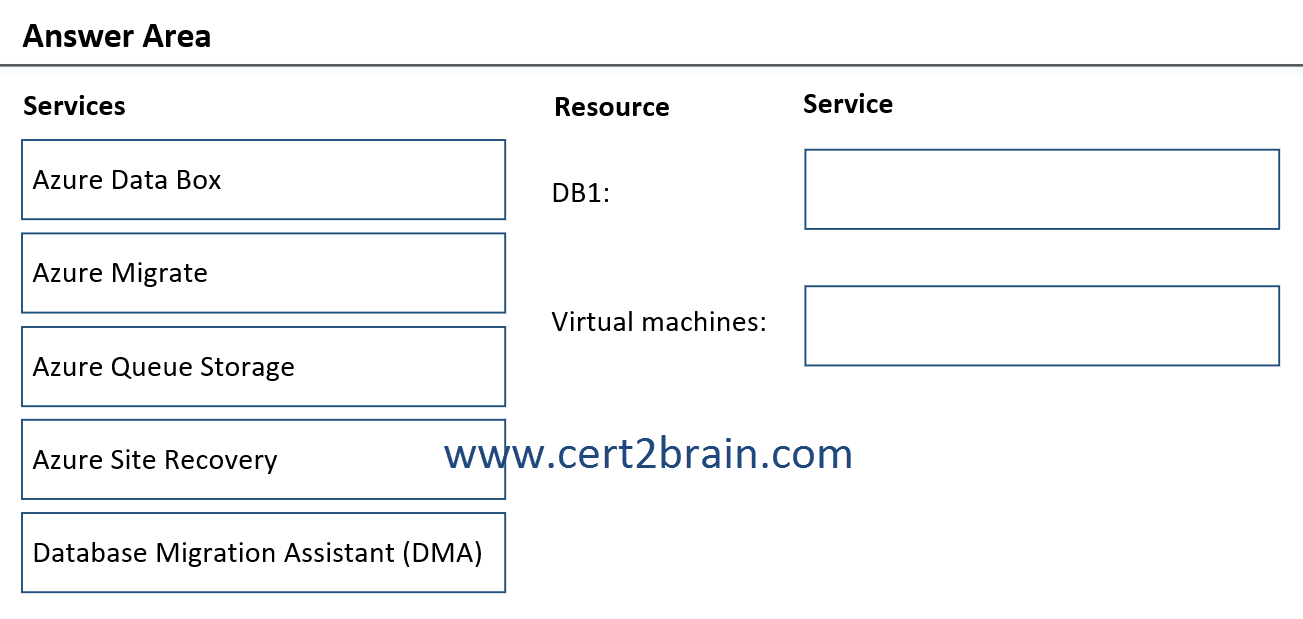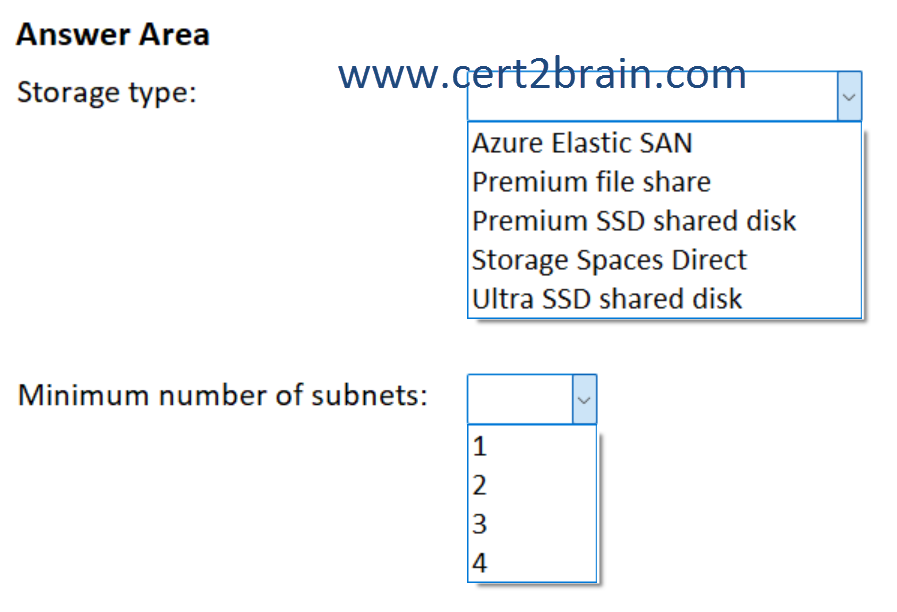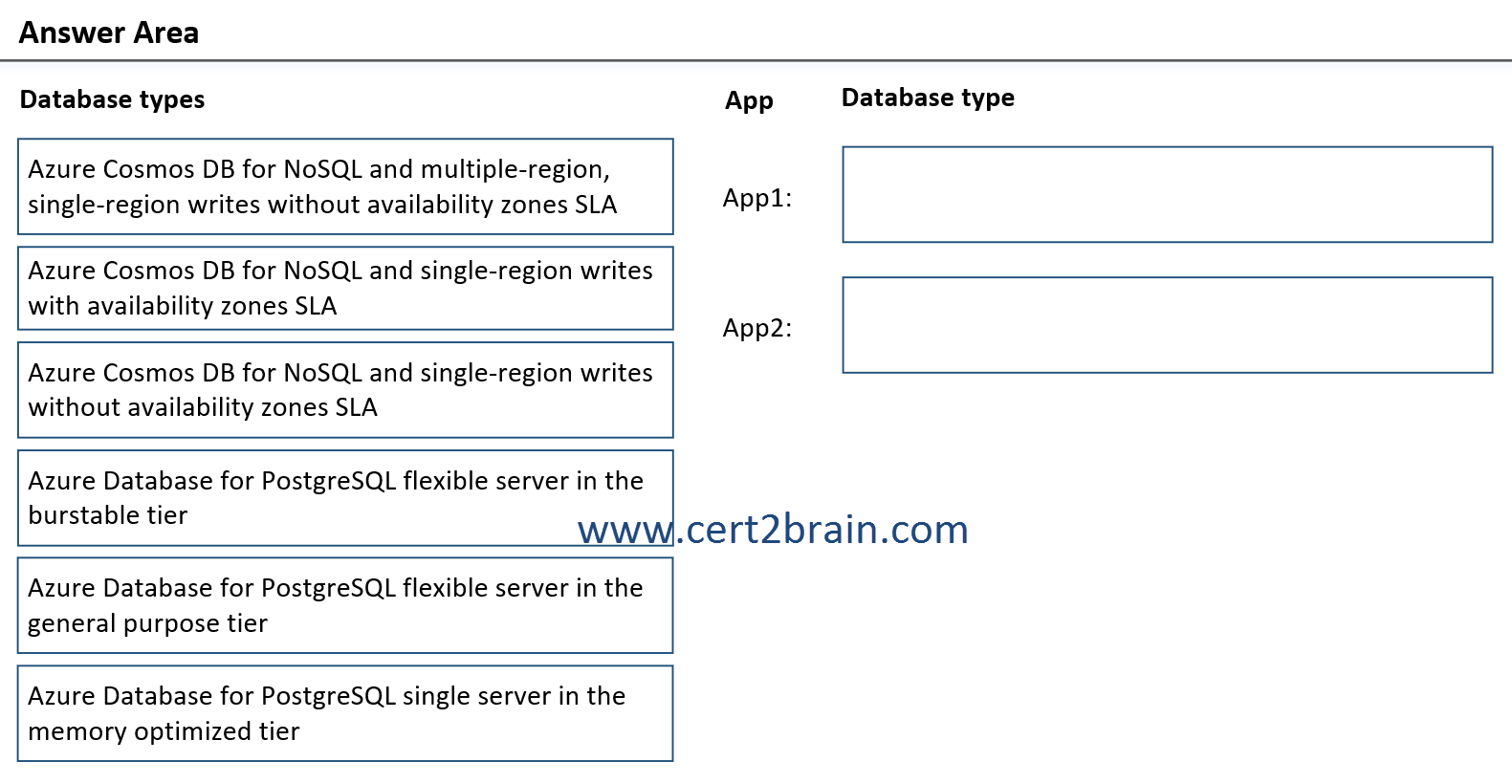Microsoft - AZ-305: Designing Microsoft Azure Infrastructure Solutions
Sample Questions
Question: 436
Measured Skill: Design infrastructure solutions (25-30%)
You have an Azure subscription. The subscription contains an app named App1 that uses the resources shown in the following table.

You need to recommend a solution to minimize how long it takes for App1 to obtain product details and access user profiles during high data load times.
What should you include in the recommendation?| A | Azure Cache for Redis |
| B | Azure Queue Storage |
| C | Azure Front Door |
| D | Azure Content Delivery Network (CDN) |
| E | Azure Traffic Manager |
Correct answer: AExplanation:
Azure Cache for Redis provides an in-memory data store based on the Redis software. Redis improves the performance and scalability of an application that uses backend data stores heavily. It's able to process large volumes of application requests by keeping frequently accessed data in the server memory, which can be written to and read from quickly. Redis brings a critical low-latency and high-throughput data storage solution to modern applications.
Azure Cache for Redis offers both the Redis open-source (OSS Redis) and a commercial product from Redis Inc. (Redis Enterprise) as a managed service. It provides secure and dedicated Redis server instances and full Redis API compatibility. Microsoft operates the service, hosted on Azure, and usable by any application within or outside of Azure.
Azure Cache for Redis can be used as a distributed data or content cache, a session store, a message broker, and more. It can be deployed standalone. Or, it can be deployed along with other Azure database services, such as Azure SQL or Azure Cosmos DB.
Reference: What is Azure Cache for Redis?
Question: 437
Measured Skill: Design infrastructure solutions (25-30%)
You have an on-premises server named Server1 that runs Windows Server 2016 and contains a Microsoft SQL Server 2016 database named DB1.
You have an Azure subscription.
You plan to migrate DB1 to Azure.
You use the Azure Database Migration Service to assess DB1 and receive the assessment results shown in the following table.

You need to recommend a migration target for DB1. The migration target must meet the following requirements:
- Eliminate the need for post-migration operating system maintenance.
- Minimize administrative effort to prepare for the migration.
What should you recommend?| A | Azure Cosmos DB for NoSQL |
| B | SQL Server on Azure Virtual Machines |
| C | Azure Cosmos DB for PostgreSQL |
| D | Azure SQL Managed Instance |
| E | Azure SQL Database |
Correct answer: DExplanation:
We should recommend Azure SQL Managed Instance as the migration target. Azure SQL Managed Instance is a recommended target option for SQL Server workloads that require a fully managed service without having to manage virtual machines or their operating systems. SQL Managed Instance enables you to move your on-premises applications to Azure with minimal application or database changes. It offers complete isolation of your instances with native virtual network support.
Note: the "Eliminate the need for post-migration operating system maintenance" requirement rules out SQL Server on Azure Virtual Machines, because VMs still require OS patching and maintenance. We have to choose a PaaS option as the migration target to eliminate the need for post-migration operating system maintenance.
Reference: Migration overview: SQL Server to Azure SQL Managed Instance
Question: 438
Measured Skill: Design infrastructure solutions (25-30%)
You have a 500-TB, on premises Microsoft SQL Server database named DB1.
You have an on-premises datacenter that contains virtual machines. The virtual machines host database, web, file and application resources.
You have an Azure subscription.
You need to migrate DB1 and the virtual machines to Azure. The solution must meet the following requirements:
- During the migration of DB1, data cannot be transmitted over the internet, and the impact on the internet must be minimized.
- The migration of the virtual machines must support a test migration before the production migration.
- During the migration of the virtual machines, downtime must be minimized.
What should you use for each migration?
(To answer, drag the appropriate services to the correct targets. Each service may be used once, more than once, or not at all. NOTE: Each correct selection is worth one point.)
| A | DB1: Azure Data Box
Virtual machines: Azure Site Recovery |
| B | DB1: Azure Migrate
Virtual machines: Azure Migrate |
| C | DB1: Azure Queue Storage
Virtual machines: Azure Data Box |
| D | DB1: Azure Site Recovery
Virtual machines: Azure Queue Storage |
| E | DB1: Database Migration Assistant (DMA)
Virtual machines: Azure Site Recovery |
| F | DB1: Database Migration Assistant (DMA)
Virtual machines: Azure Migrate |
Correct answer: AExplanation:
During the migration of DB1, data cannot be transmitted over the internet, and the impact on the internet must be minimized. To meet this requirement, we should use Azure Data Box for the migration of DB1. Azure Data Box lets you transfer very large datasets offline by physically shipping secure storage devices to Microsoft.
To migrate the virtual machines and to support a test migration before the production migration, we should use Azure Site Recovery. Azure Site Recovery (ASR) provides replication of on-premises virtual machines and physical servers to Azure. Azure Site Recovery supports test failover without impact on the production environment and ensures near-zero downtime during cutover.
References:
What is Azure Data Box?
About Site Recovery
Question: 439
Measured Skill: Design infrastructure solutions (25-30%)
You have an Azure subscription.
You are designing a Microsoft SQL Server failover cluster instance (FCI) solution. The solution must meet the following requirements:
- Ensure that the FCI contains three virtual machines that run Windows Server 2025.
- Place the virtual machines and storage resources in three availability zones to provide an availability SLA of 99.99%.
- Minimize read/write latency for storage without affecting the availability SLA of the virtual machines.
- Ensure that neither a network load balancer nor a distributed network name (DNN) are required.
- Minimize administrative effort.
You need to recommend which type of storage to use and the minimum number of subnets required for the FCI.
What should you recommend?
(To answer, select the appropriate options in the answer area. NOTE: Each correct selection is worth one point.)
| A | Storage type: Azure Elastic SAN
Minimum number of subnets: 3 |
| B | Storage type: Azure Elastic SAN
Minimum number of subnets: 1 |
| C | Storage type: Premium file share
Minimum number of subnets: 2 |
| D | Storage type: Premium SSD shared disk
Minimum number of subnets: 4 |
| E | Storage type: Storage Spaces Direct
Minimum number of subnets: 4 |
| F | Storage type: Ultra SSD shared disk
Minimum number of subnets: 3 |
Correct answer: BExplanation:
We should use Azure Elastic SAN to provide the storage. Elastic SAN is a fully managed, zone-resilient SAN-as-a-service that can present block LUNs suitable for a Windows Server Failover Cluster Instance (FCI). Azure Elastic SAN volumes can connect to a wide variety of compute resources using the internet Small Computer Systems Interface (iSCSI) protocol.
Azure allows you to deploy the cluster nodes into a single subnet while placing the VMs into different availability zones. For a minimal FCI deployment you can run the cluster on one subnet. You can use the same subnet for cluster communication, client access and storage attachments. Additional subnets are recommended for traffic isolation or security segmentation but not required as a minimum.
Reference: What is Azure Elastic SAN?
Question: 440
Measured Skill: Design data storage solutions (25-30%)
You have an Azure subscription.
You are designing a deployment plan for the Azure App Service web apps shown in the following table.

You need to recommend a database solution for the apps. The solution must meet the following requirements:
- Provide zone redundancy.
- Minimize costs and administrative effort.
What should you include in the recommendation for each app?
(To answer, drag the appropriate database types to the correct apps. Each database type may be used once, more than once, or not at all. NOTE: Each correct selection is worth one point.)
| A | App1: Azure Cosmos DB for NoSQL and single-region writes without availability zones SLA
App2: Azure Database for PostgreSQL flexible server in the burstable tier |
| B | App1: Azure Cosmos DB for NoSQL and single-region writes with availability zones SLA
App2: Azure Database for PostgreSQL flexible server in the general purpose tier |
| C | App1: Azure Database for PostgreSQL single server in the memory optimized tier
App2: Azure Cosmos DB for NoSQL and single-region writes without availability zones SLA |
| D | App1: Azure Cosmos DB for NoSQL and multiple-region, single-region writes without availability zones SLA
App2: Azure Cosmos DB for NoSQL and multiple-region, single-region writes without availability zones SLA |
| E | App1: Azure Database for PostgreSQL flexible server in the general purpose tier
App2: Azure Database for PostgreSQL flexible server in the general purpose tier |
| F | App1: Azure Cosmos DB for NoSQL and single-region writes with availability zones SLA
App2: Azure Database for PostgreSQL single server in the memory optimized tier |
Correct answer: EExplanation:
Azure Database for PostgreSQL supports high availability by provisioning physically separated primary and standby replicas, either within the same availability zone (zonal) or across availability zones (zone-redundant). This high availability model is designed to ensure that committed data is never lost during failures. In a high availability (HA) setup, data is synchronously committed to both the primary and standby servers. The model is designed so that the database doesn't become a single point of failure in your software architecture.
Availability zones are physically separate groups of datacenters within each Azure region. When one zone fails, services can fail over to one of the remaining zones.
Azure Database for PostgreSQL supports both zone-redundant and zonal models for high availability configurations. Both high availability configurations enable automatic failover capability with zero data loss during both planned and unplanned events.
Zone-redundant. Zone redundant high availability deploys a standby replica in a different zone with automatic failover capability. Zone redundancy provides the highest level of availability, but you need to configure application redundancy across zones. For that reason, choose zone redundancy when you want protection from availability zone level failures and when latency across the availability zones is acceptable. While there can be some latency impact on writes and commits due to synchronous replication, it doesn't affect read queries. This impact is specific to your workloads, the SKU type you select, and the region.
Zone-redundant isn't supported for the burstable compute tier.
The Zone-redundancy model offers an uptime for an SLA for about 99.99%.
References:
What is Azure Database for PostgreSQL?
High availability (reliability) in Azure Cosmos DB for NoSQL
High availability (Reliability) in Azure Database for PostgreSQL